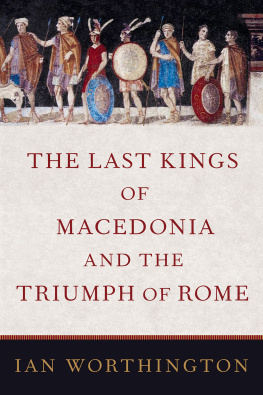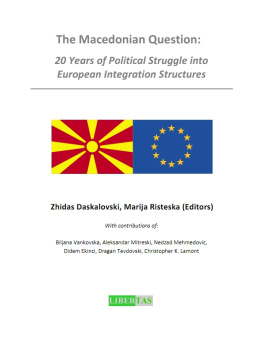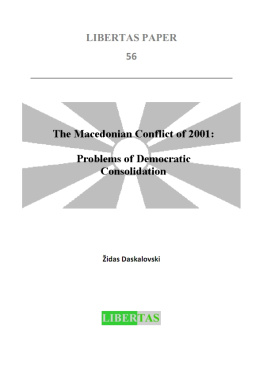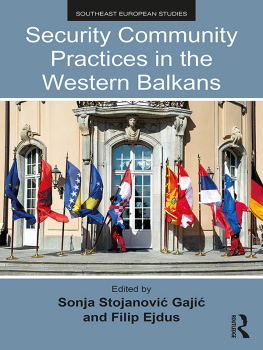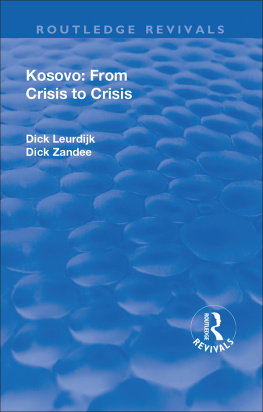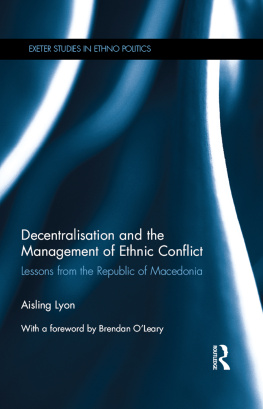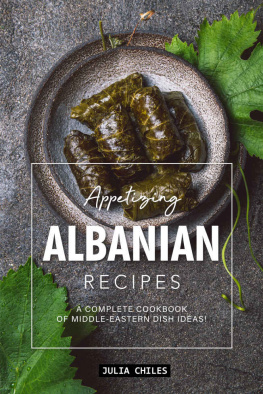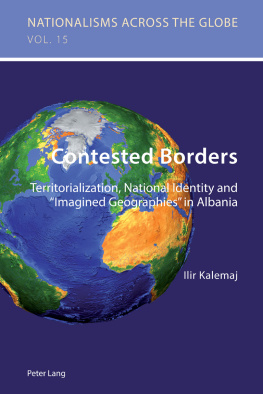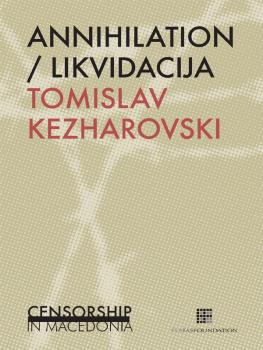Copyright 2012 University of Pennsylvania Press
All rights reserved. Except for brief quotations used
for purposes of review or scholarly citation, none of this book
may be reproduced in any form by any means without written
permission from the publisher.
Published by
University of Pennsylvania Press
Philadelphia, Pennsylvania 19104-4112
www.upenn.edu/pennpress
Printed in the United States of America on acid-free paper
10 9 8 7 6 5 4 3 2 1
Library of Congress Cataloging-in-Publication Data
Neofotistos, Vasiliki P.
The risk of war : everyday sociality in the Republic of Macedonia / Vasiliki P. Neofotistos. 1st. ed.
p. cm. (The ethnography of political violence)
Includes bibliographical references and index.
ISBN 978-0-8122-4399-4 (hardcover : alk. paper)
1. Macedonia (Republic)Ethnic relationsPolitical aspects. 2. Macedonia (Republic)Social conditions. 3. Macedonia (Republic)Politics and government1992 I. Title. II. Series: Ethnography of political violence.
DR2253.N46 2012
949.7603dc23 2011044322
Introduction
On 16 February 2001, members of a journalistic team working for the Macedonian TV station A1 claimed that they had been kidnapped by armed Albanian men, some in black uniforms, for a few hours. By all accounts this event took place in the Albanian-populated village of Tanuevci in northern Macedonia, just across the border from UN-administered Kosovo (see Media sources proclaimed that after the journalists were released, a Macedonian Border Patrol unit entered the village and clashed with the armed group. After an approximately hour-long gun battle, the armed group reportedly withdrew into Kosovo on the other side of the border.
These are the beginnings of the 2001 armed conflict between Macedonian government forces and the Albanian NLA in the Republic of Macedonia. According to the NLA, the goal of the insurgency was to secure greater rights for Albanians in Macedonia, who make up 25.17 percent of the overall population of the country. The decision to take up arms was allegedly motivated by the failure of the Macedonian state, ten years after independence, to pass the laws necessary to carry certain provisions of the founding Constitution into effect and hence provide the Albanian community with the rights it reportedly deserved and demanded throughout the 1990s, including the establishment of an Albanian-speaking state-sponsored university and increase in the number of Albanian employees in the public sector. Macedonian officials, on the other hand, branded the NLA as a terrorist organization and the insurgency as a provocation against the territorial integrity of the Macedonian state.

Figure 1. Map of Macedonia. Based on a UN map, UN Cartographic Section.
During the conflict, a plan for peaceful resolution, involving the exchange of populations and territories between Albania and Macedonia, was leaked to the press reportedly by the Macedonian Academy of Sciences and Arts. The plan proposed that Macedonia should give northwestern territory, where the Albanian population is most densely populated, to Kosovo, and also give Debar to Albania in return for territories with Macedonian majorities in southeastern Albania.
The conflict heightened feelings of insecurity among Macedonias population, and nobody inside or outside the country knew what to expect. There were speculations that Macedonia would be engulfed in civil war, be partitioned, or become a UN protectorate. In what follows, I provide an ethnographic account of the ways middle- and working-class Muslim Albanians and Orthodox Macedonians in Macedonias capital practiced daily life at a time when fear and uncertainty regarding their existence and the viability of the state were intense and widespread. I do not want to give the wrong impression that members of other communities in the country, such as Roms, Turks, and Vlahs, were unaffected by the crisis. I consider the following questions. What impact did the 2001 conflict have on everyday life? How did social actors who did not engage in armed combat construct social reality at the time? How did they position themselves vis--vis people of different ethnonational backgrounds? In addressing these questions, I explore the ways middle- and working-class Macedonians and Albanians in Skopje made sense of violence and tried to restore a sense of order and stability in the midst of uncertainty and political turmoil.
The 2001 Conflict as a Success Story
The 2001 armed conflict was neither the first nor the last crisis in Macedonia. After the country emerged from the dissolution of Yugoslavia as an independent nation-state in 1991, numerous key events occurred (see not only disrupted everyday life but also brought about new modes of sociopolitical action and redefined sociopolitical categories of belongingwhat Veena Das has called critical events (1995: 6).
Compared to previous events, however, the crisis of 2001 was unique in terms of its duration and intensity, and also its social and political ramifications for Macedonias future. The conflict lasted six months, claimed a few hundred lives on both the Macedonian and Albanian sides, and generated hundreds of internally displaced persons. Fighting was limited to mountainous areas in the northwestern parts of the country bordering on Kosovo, where a segment of the Albanian population is heavily concentrated, and did not spread to areas that border on Albania and have large concentrations of Albanians, such as the western town of Debar, the southwestern town of Struga, and the villages in between and farther east. With the benefit of hindsight, we can say that the 2001 conflict was a foundational moment in contemporary Macedonian history in the sense that it ushered in unprecedented structural changeit was what political scientists term a critical juncture (see Calder 2008). For example, the Constitution was amended, state funds were provided for university level education in Albanian, local self-government was strengthened by incorporating Albanians, and in units of local self-government where at least 20 percent of the population spoke a language other than Macedonian that language and its alphabet became official in addition to Macedonian and the Cyrillic alphabet (see Appendix). Nonetheless, while the conflict was unfolding, nobody in Macedonia or abroad could tell if all-out war would be averted or a new power structure be established.
Following the signing of the Ohrid Agreement in August 2001, Macedonia was declared a success story by politicians in Macedonia, EU officials, the international media, and Western nongovernmental organizations. Talk proliferated about how Macedonias political leadership with the diplomatic assistance of the EU and the U.S. had averted yet another war in the Balkans. These assessments miss a crucial factor, namely the way social actors on the ground, including members of the Albanian community for whom the conflict was allegedly fought, positioned themselves in relation to the insurgency and to each other during interpersonal and intergroup interactions. Even the most detailed study to date of the events that comprised the 2001 crisis,


